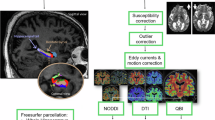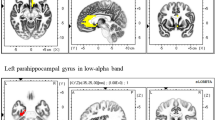Abstract
Recent structural imaging studies have described hippocampal volume changes following electroconvulsive therapy (ECT). It has been proposed that serum brain-derived neurotrophic factor (sBDNF)-mediated neuroplasticity contributes critically to brain changes following antidepressant treatment. To date no studies have investigated the relationship between changes in hippocampal volume, mood, and sBDNF following ECT. Here, we combine these measurements in a longitudinal study of severe late-life unipolar depression (LLD). We treated 88 elderly patients with severe LLD twice weekly until remission (Montgomery–Åsberg Depression Rating Scale (MADRS) <10). sBDNF and MADRS were obtained before ECT (T0), after the sixth ECT (T1), 1 week after the last ECT (T2), 4 weeks after the last ECT (T3), and 6 months after the last ECT (T4). Hippocampal volumes were quantified by manual segmentation of 3T structural magnetic resonance images in 66 patients at T0 and T2 and in 23 patients at T0, T2, and T4. Linear mixed models (LMM) were used to examine the evolution of MADRS, sBDNF, and hippocampal volume over time. Following ECT, there was a significant decrease in MADRS scores and a significant increase in hippocampal volume. Hippocampal volume decreased back to baseline values at T4. Compared with T0, sBDNF levels remained unchanged at T1, T2, and T3. There was no coevolution between changes in MADRS scores, hippocampal volume, and sBDNF. Hippocampal volume increase following ECT is an independent neurobiological effect unrelated to sBDNF and depressive symptomatology, suggesting a complex mechanism of action of ECT in LLD.
Similar content being viewed by others
Log in or create a free account to read this content
Gain free access to this article, as well as selected content from this journal and more on nature.com
or
References
Abbott CC, Jones T, Lemke NT, Gallegos P, McClintock SM, Mayer AR et al (2014). Hippocampal structural and functional changes associated with electroconvulsive therapy response. Transl Psychiatry 4: e483.
Andrade C, Bolwig TG (2014). Electroconvulsive therapy, hypertensive surge, blood-brain barrier breach, and amnesia: exploring the evidence for a connection. J ECT 30: 160–164.
Bessa JM, Ferreira D, Melo I, Marques F, Cerqueira JJ, Palha JA et al (2009). The mood-improving actions of antidepressants do not depend on neurogenesis but are associated with neuronal remodeling. Mol Psychiatry 14: 739.
Beunckens C, Molenberghs G, Kenward MG (2005). Direct likelihood analysis versus simple forms of imputation for missing data in randomized clinical trials. Clin Trials 2: 379–386.
Bolwig TG (2011). How does electroconvulsive therapy work? Theories on its mechanism. Can J Psychiatry 56: 13–18.
Bolwig TG, Jorgensen OS (1980). Synaptic proteins after electroconvulsive stimulation: reversibility and regional differences in the brain. Acta Psychiatr Scand 62: 486–493.
Bouckaert F, De Winter FL, Emsell L, Dols A, Rhebergen D, Wampers M et al (2015). Grey matter volume increase following electroconvulsive therapy in patients with late life depression: a longitudinal MRI study. J Psychiatry Neurosci 40: 140322.
Bouckaert F, Sienaert P, Obbels J, Dols A, Vandenbulcke M, Stek M et al (2014). ECT: its brain enabling effects: a review of electroconvulsive therapy-induced structural brain plasticity. J ECT 30: 143–151.
Bumb JM, Aksay SS, Janke C, Kranaster L, Geisel O, Gass P et al (2015). Focus on ECT seizure quality: serum BDNF as a peripheral biomarker in depressed patients. Eur Arch Psychiatry Clin Neurosci 265: 227–232.
Bus BA, Molendijk ML, Penninx BJ, Buitelaar JK, Kenis G, Prickaerts J et al (2011). Determinants of serum brain-derived neurotrophic factor. Psychoneuroendocrinology 36: 228–239.
Bus BA, Molendijk ML, Tendolkar I, Penninx BW, Prickaerts J, Elzinga BM et al (2015). Chronic depression is associated with a pronounced decrease in serum brain-derived neurotrophic factor over time. Mol Psychiatry 20: 602–608.
Bus BA, Tendolkar I, Franke B, de Graaf J, den Heijer M, Buitelaar JK et al (2012). Serum brain-derived neurotrophic factor: determinants and relationship with depressive symptoms in a community population of middle-aged and elderly people. World J Biol Psychiatry 13: 39–47.
Calabrese F, Guidotti G, Racagni G, Riva MA (2013). Reduced neuroplasticity in aged rats: a role for the neurotrophin brain-derived neurotrophic factor. Neurobiol Aging 34: 2768–2776.
Cousins DA, Aribisala B, Nicol Ferrier I, Blamire AM (2013). Lithium, gray matter, and magnetic resonance imaging signal. Biol Psychiatry 73: 652–657.
Dukart J, Regen F, Kherif F, Colla M, Bajbouj M, Heuser I et al (2014). Electroconvulsive therapy-induced brain plasticity determines therapeutic outcome in mood disorders. Proc Natl Acad Sci USA 111: 1156–1161.
Duman RS, Aghajanian GK (2012). Synaptic dysfunction in depression: potential therapeutic targets. Science 338: 68–72.
Elfving B, Wegener G (2012). Electroconvulsive seizures stimulate the vegf pathway via mTORC1. Synapse 66: 340–345.
Erickson KI, Miller DL, Roecklein KA (2012). The aging hippocampus: interactions between exercise, depression, and BDNF. Neuroscientist 18: 82–97.
Erickson KI, Prakash RS, Voss MW, Chaddock L, Heo S, McLaren M et al (2010). Brain-derived neurotrophic factor is associated with age-related decline in hippocampal volume. J Neurosci 30: 5368–5375.
Frisoni GB, Jack CR Jr . Bocchetta M, Bauer C, Frederiksen KS, Liu Y et al (2015). The EADC-ADNI harmonized protocol for manual hippocampal segmentation on magnetic resonance: evidence of validity. Alzheimers Dement 11: 111–125.
Frodl T, Jager M, Smajstrlova I, Born C, Bottlender R, Palladino T et al (2008). Effect of hippocampal and amygdala volumes on clinical outcomes in major depression: a 3-year prospective magnetic resonance imaging study. J Psychiatry Neurosci 33: 423–430.
Hesse GW, Teyler TJ (1976). Reversible loss of hippocampal long term potentiation following electronconvulsive seizures. Nature 264: 562–564.
Jack CR Jr . Twomey CK, Zinsmeister AR, Sharbrough FW, Petersen RC, Cascino GD (1989). Anterior temporal lobes and hippocampal formations: normative volumetric measurements from MR images in young adults. Radiology 172: 549–554.
Jain S, Sima DM, Ribbens A, Cambron M, Maertens A, Van Hecke W et al (2015). Automatic segmentation and volumetry of multiple sclerosis brain lesions from MR images. Neuroimage Clin 8: 367–375.
Jorgensen A, Magnusson P, Hanson LG, Kirkegaard T, Benveniste H, Lee H et al (2015). Regional brain volumes, diffusivity, and metabolite changes after electroconvulsive therapy for severe depression. Acta Psychiatr Scand 133: 154–164.
Joshi SH, Espinoza RT, Pirnia T, Shi J, Wang Y, Ayers B et al (2015). Structural plasticity of the hippocampus and amygdala induced by electroconvulsive therapy in major depression. Biol Psychiatry 79: 282–292.
Kerner N, Prudic J (2014). Current electroconvulsive therapy practice and research in the geriatric population. Neuropsychiatry (London) 4: 33–54.
Kunigiri G, Jayakumar PN, Janakiramaiah N, Gangadhar BN (2007). MRI T(2) relaxometry of brain regions and cognitive dysfunction following electroconvulsive therapy. Indian J Psychiatry 49: 195–199.
Molendijk ML, Spinhoven P, Polak M, Bus BA, Penninx BW, Elzinga BM (2013). Serum BDNF concentrations as peripheral manifestations of depression: evidence from a systematic review and meta-analyses on 179 associations (N=9484). Mol Psychiatry 19: 791–800.
Montgomery SA, Asberg M (1979). A new depression scale designed to be sensitive to change. Br J Psychiatry 134: 382–389.
Nickl-Jockschat T, Palomero GN, Kumar V, Hoffstaedter F, Brugmann E, Habel U et al (2016). Are morphological changes necessary to mediate the therapeutic effects of electroconvulsive therapy? Eur Arch Psychiatry Clin Neurosci 266: 261–267.
Nordanskog P, Dahlstrand U, Larsson MR, Larsson EM, Knutsson L, Johanson A (2010). Increase in hippocampal volume after electroconvulsive therapy in patients with depression: a volumetric magnetic resonance imaging study. J ECT 26: 62–67.
Nordanskog P, Larsson MR, Larsson EM, Johanson A (2014). Hippocampal volume in relation to clinical and cognitive outcome after electroconvulsive therapy in depression. Acta Psychiatr Scand 129: 303–311.
Nordgren M, Karlsson T, Svensson M, Koczy J, Josephson A, Olson L et al (2013). Orchestrated regulation of nogo receptors, lotus, AMPA receptors and BDNF in an ECT model suggests opening and closure of a window of synaptic plasticity. PLoS One 8: e78778.
Ota M, Noda T, Sato N, Okazaki M, Ishikawa M, Hattori K et al (2015). Effect of electroconvulsive therapy on gray matter volume in major depressive disorder. J Affect Disord 186: 186–191.
Pilar-Cuellar F, Vidal R, Diaz A, Castro E, dos Anjos S, Pascual-Brazo J et al (2013). Neural plasticity and proliferation in the generation of antidepressant effects: hippocampal implication. Neural Plast (2013) 537265.
Polyakova M, Schroeter ML, Elzinga BM, Holiga S, Schoenknecht P, de Kloet ER et al (2015). Brain-derived neurotrophic factor and antidepressive effect of electroconvulsive therapy: systematic review and meta-analyses of the preclinical and clinical literature. PLoS One 10: e0141564.
Price JL, Drevets WC (2010). Neurocircuitry of mood disorders. Neuropsychopharmacology 35: 192–216.
Rapinesi C, Kotzalidis GD, Curto M, Serata D, Ferri VR, Scatena P et al (2015). Electroconvulsive therapy improves clinical manifestations of treatment-resistant depression without changing serum BDNF levels. Psychiatry Res 227: 171–178.
Sartorius A, Demirakca T, Böhringer A, von Hogenberg C, Aksay SS, Bumb JM et al (2016). Electroconvulsive therapy increases temporal gray matter volume and cortical thickness. Eur Neuropsychopharmacol 26: 506–517.
Sartorius A, Hellweg R, Litzke J, Vogt M, Dormann C, Vollmayr B et al (2009). Correlations and discrepancies between serum and brain tissue levels of neurotrophins after electroconvulsive treatment in rats. Pharmacopsychiatry 42: 270–276.
Sen S, Duman R, Sanacora G (2008). Serum brain-derived neurotrophic factor, depression, and antidepressant medications: meta-analyses and implications. Biol Psychiatry 64: 527–532.
Sexton CE, Mackay CE, Ebmeier KP (2013). A systematic review and meta-analysis of magnetic resonance imaging studies in late-life depression. Am J Geriatr Psychiatry 21: 184–195.
Sheehan DV, Lecrubier Y, Sheehan KH, Amorim P, Janavs J, Weiller E et al (1998). The Mini-International Neuropsychiatric Interview (M.I.N.I.): the development and validation of a structured diagnostic psychiatric interview for DSM-IV and ICD-10. J Clin Psychiatry 59 (Suppl 20): 22–33.
Sousa N, Lukoyanov NV, Madeira MD, Almeida OF, Paula-Barbosa MM (2000). Reorganization of the morphology of hippocampal neurites and synapses after stress-induced damage correlates with behavioral improvement. Neuroscience 97: 253–266.
Spalding KL, Bergmann O, Alkass K, Bernard S, Salehpour M, Huttner HB et al (2013). Dynamics of hippocampal neurogenesis in adult humans. Cell 153: 1219–1227.
Szabo K, Hirsch JG, Krause M, Ende G, Henn FA, Sartorius A et al (2007). Diffusion weighted MRI in the early phase after electroconvulsive therapy. Neurol Res 29: 256–259.
Tendolkar I, van Beek M, van Oostrom I, Mulder M, Janzing J, Oude Voshaar R et al (2013). Electroconvulsive therapy increases hippocampal and amygdala volume in therapy refractory depression: a longitudinal pilot study. Psychiatry Res 214: 197–203.
Vaidya VA, Siuciak JA, Du F, Duman RS (1999). Hippocampal mossy fiber sprouting induced by chronic electroconvulsive seizures. Neuroscience 89: 157–166.
van der Lijn F, den Heijer T, Breteler MM, Niessen WJ (2008). Hippocampus segmentation in MR images using atlas registration, voxel classification, and graph cuts. Neuroimage 43: 708–720.
Acknowledgements
We thank Saurabh Jain (icoMetrix, Belgium), ResPECT (Research consortium for Psychiatry and ECT), and Anna Paauw (data management, GGZinGeest, the Netherlands).
Author information
Authors and Affiliations
Corresponding author
Rights and permissions
About this article
Cite this article
Bouckaert, F., Dols, A., Emsell, L. et al. Relationship Between Hippocampal Volume, Serum BDNF, and Depression Severity Following Electroconvulsive Therapy in Late-Life Depression. Neuropsychopharmacol 41, 2741–2748 (2016). https://doi.org/10.1038/npp.2016.86
Received:
Revised:
Accepted:
Published:
Issue date:
DOI: https://doi.org/10.1038/npp.2016.86
This article is cited by
-
The role of neurotrophic factors in novel, rapid psychiatric treatments
Neuropsychopharmacology (2024)
-
How electroconvulsive therapy works in the treatment of depression: is it the seizure, the electricity, or both?
Neuropsychopharmacology (2024)
-
The heterogeneity of late-life depression and its pathobiology: a brain network dysfunction disorder
Journal of Neural Transmission (2023)
-
Electroconvulsive therapy, electric field, neuroplasticity, and clinical outcomes
Molecular Psychiatry (2022)
-
Involvement of oxidative pathways and BDNF in the antidepressant effect of carvedilol in a depression model induced by chronic unpredictable stress
Psychopharmacology (2022)



